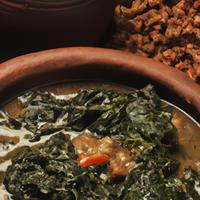
1 serving (200 grams) contains 300 calories, 5.0 grams of protein, 25.0 grams of fat, and 15.0 grams of carbohydrates.

Log this food in SnapCalorie

Nutrition Information
Calories |
352.9 | ||
|---|---|---|---|
% Daily Value* |
|||
| Total Fat | 29.4 g | 37% | |
| Saturated Fat | 17.6 g | 88% | |
| Polyunsaturated Fat | 0 g | ||
| Cholesterol | 0 mg | 0% | |
| Sodium | 588.2 mg | 25% | |
| Total Carbohydrates | 17.6 g | 6% | |
| Dietary Fiber | 3.5 g | 12% | |
| Sugars | 2.4 g | ||
| protein | 5.9 g | 11% | |
| Vitamin D | 0 mcg | 0% | |
| Calcium | 58.8 mg | 4% | |
| Iron | 1.8 mg | 10% | |
| Potassium | 470.6 mg | 10% | |
* Percent Daily Values are based on a 2,000 calorie diet. Your daily values may be higher or lower depending on your calorie needs.
Food Attributes
Source of Calories
About Laing
Laing is a flavorful Filipino dish originating from the Bicol region, known for its rich and creamy texture. It is made primarily from dried taro leaves simmered in coconut milk, combined with spices such as garlic, onion, ginger, and chili peppers for a spicy kick. Sometimes, proteins like dried fish or pork are added for extra flavor. Laing is naturally high in fiber due to the taro leaves and provides essential vitamins and minerals, including vitamin A and calcium. Coconut milk contributes healthy fats that can support heart health when consumed in moderation, though its calorie and saturated fat content should be considered for those managing dietary intake. Laing is typically served alongside rice and enjoyed as a hearty, satisfying meal that showcases the rich flavors of Filipino cuisine.



